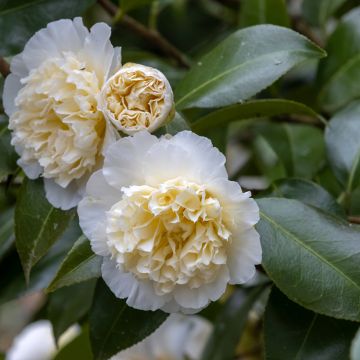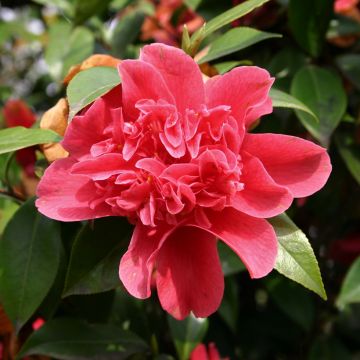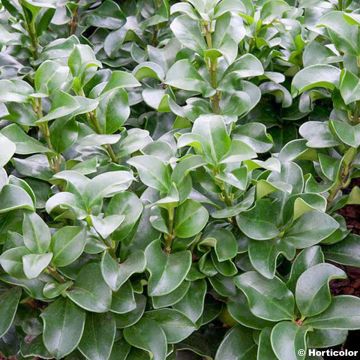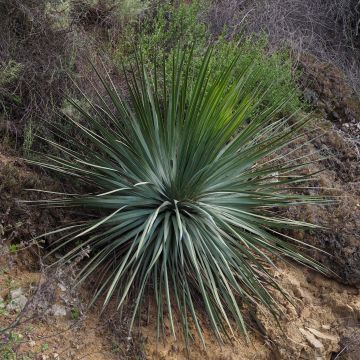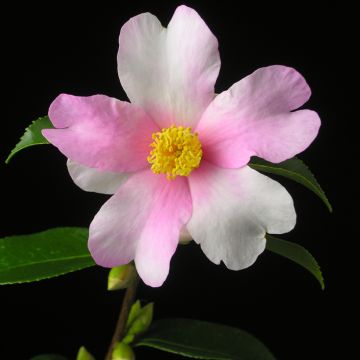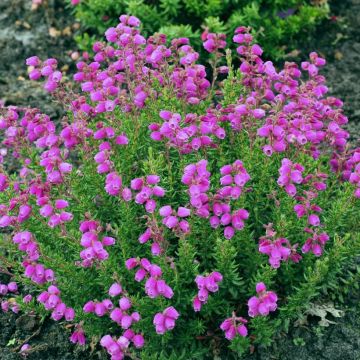

Camellia japonica de Higo Okan
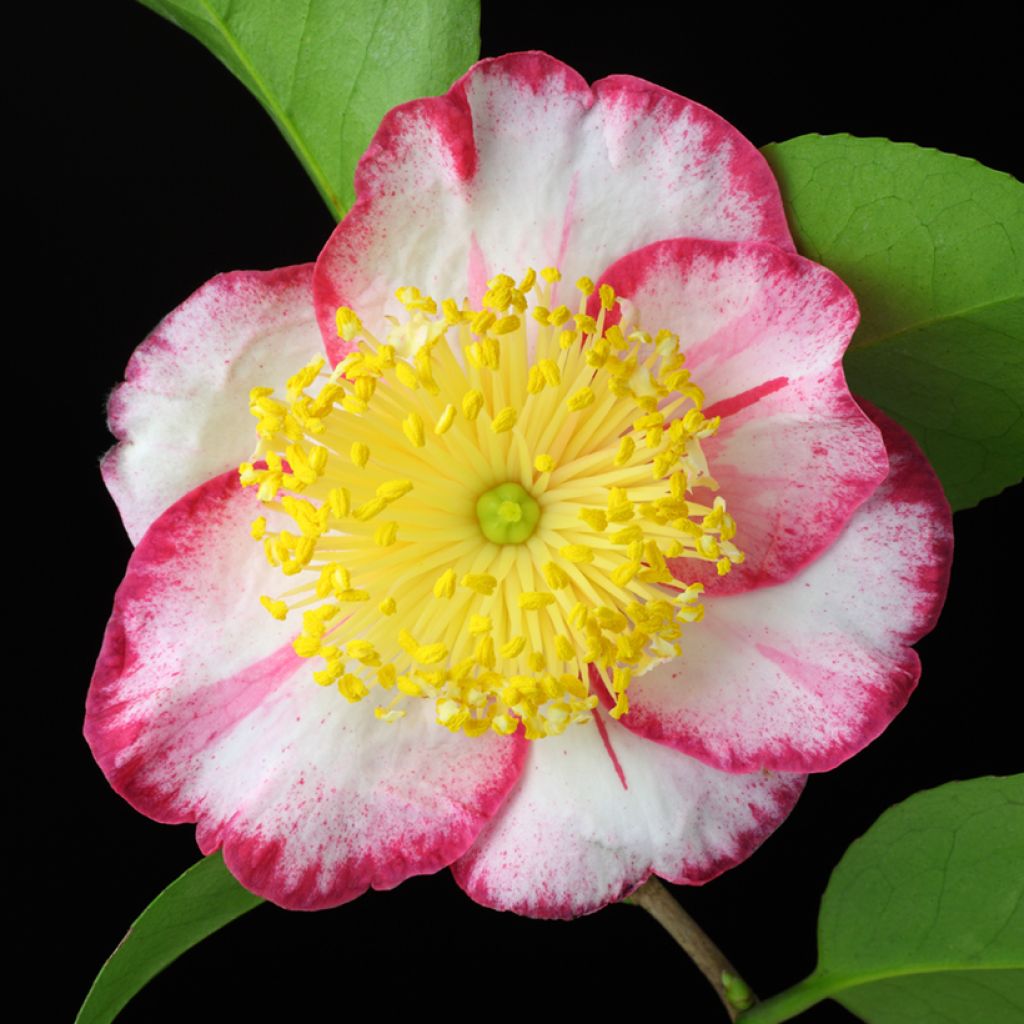

Camellia japonica de Higo Okan
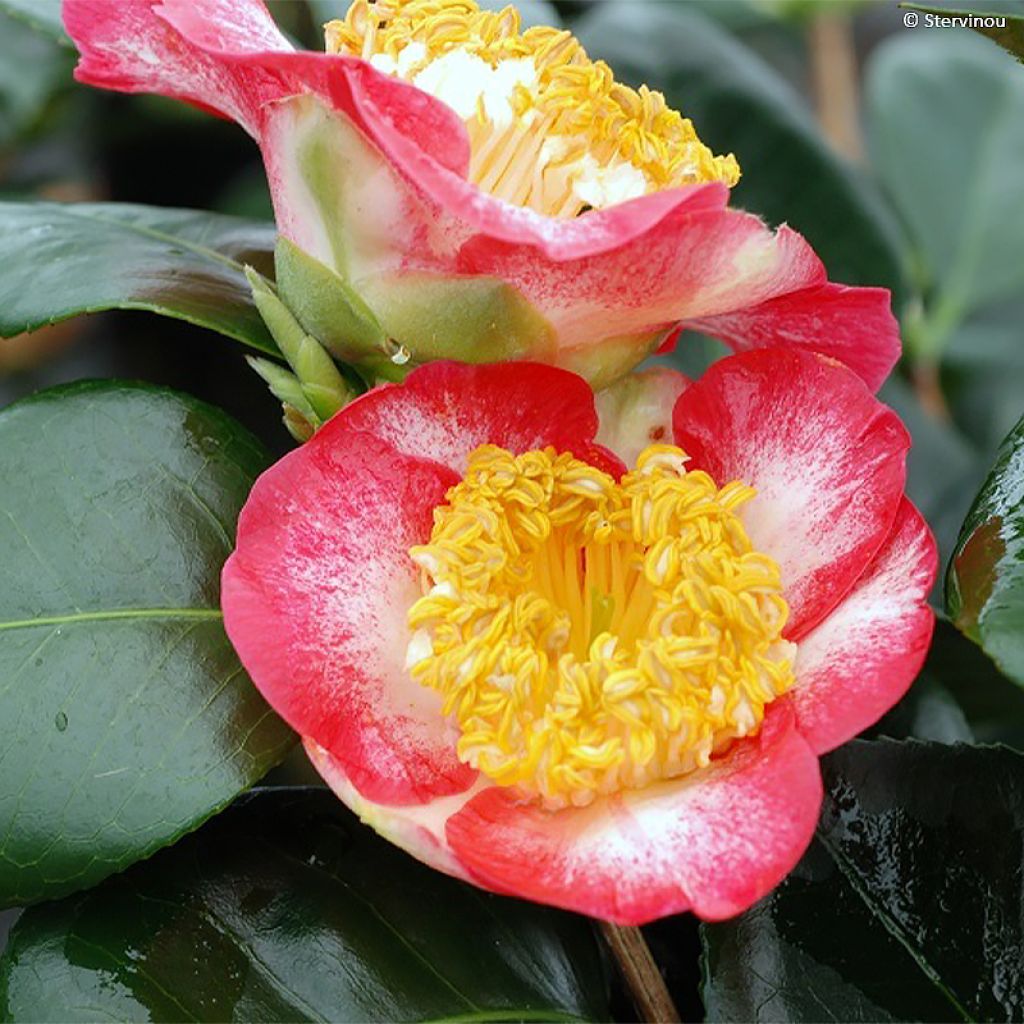

Camellia japonica de Higo Okan
Camellia japonica de Higo Okan
Camellia japonica de Higo Okan
Japanese Camellia, Rose of winter
This item cannot be shipped to the selected country
Delivery charge from €5.90
More information
Schedule delivery date,
and select date in basket
This plant carries a 24 months recovery warranty
More information
We guarantee the quality of our plants for a full growing cycle, and will replace at our expense any plant that fails to recover under normal climatic and planting conditions.
From €5.90 for pickup delivery and €6.90 for home delivery
Express home delivery from €8.90.
Does this plant fit my garden?
Set up your Plantfit profile →
Description
The 'Okan' Camellia is part of a group of Japanese camellias originating from the Japanese province of Higo. All of these varieties are renowned for the beauty of their large flowers with prominent stamens for which the Samurai held a deep admiration. 'Okan', a compact variety, is adorned with large, single, white flowers, more or less edged with cherry red. Its early and prolonged flowering appears on foliage of glossy dark green, elegant throughout the year. It is grown, like other Japanese camellias, in open ground or in a container, in partial shade, in a cool, slightly acidic soil, and even blooms in dense shade.
The Higo Camellia 'Okan' belongs to the family of Theaceae, like its ancestor Camellia japonica. It is a bushy, branched shrub that reaches about 80 cm (32 in) in all directions by the age of 10. From February to April it produces large, rounded floral buds. They open into flowers measuring 10 to 13 cm (4 to 5 in) in diameter, cup-shaped, composed of 5 to 6 wide, rounded petals surrounding a centre with no less than 150 to 200 long, pale yellow stamens. The foliage, which persists throughout the year, consists of large, elliptical leaves, 10 cm (4 in) long by 5 cm (2 in) wide, leathery, finely toothed along the edges. Their colour is a dark, glossy green on the upper side. While this shrub is hardy down to -15 °C in open ground, its floral buds can be destroyed by snow, icy wind, and temperatures below -5 °C.
Camellia japonica 'Okan' favours rather mild and humid climates and thrives in coastal regions, in acidic, humus-rich, well-drained soil. It requires a partially shaded to shaded site, sheltered from strong, drying winds. It can be planted e.g. in a shrub bed, alongside other acid-loving plants such as Rhododendrons, Azaleas, Cornus Kousa, Hamamelis or even Kalmia Latifolia. But it would be a shame to drown this variety in a tangle of foliage or flowers. It deserves a special place, near the entrance of the house or in a beautiful pot on the terrace, to be stored away in winter in very cold climates.
A bit of history: In Japan, the camellia is called "tsubaki". The samurai made the flower of the 'Higo tsubaki' - which grows in the shade of the forests on the northwest coast of Honshu - their prestigious emblem, most likely because its flower has a "generous heart", in line with their own courage. The Higo camellia varieties were given poetic names by these formidable warriors, including "Scented Snowstorm","Path of the Great Gate", "White Falcon", and "Pearl Light".
Report an error about the product description
Camellia japonica de Higo Okan in pictures


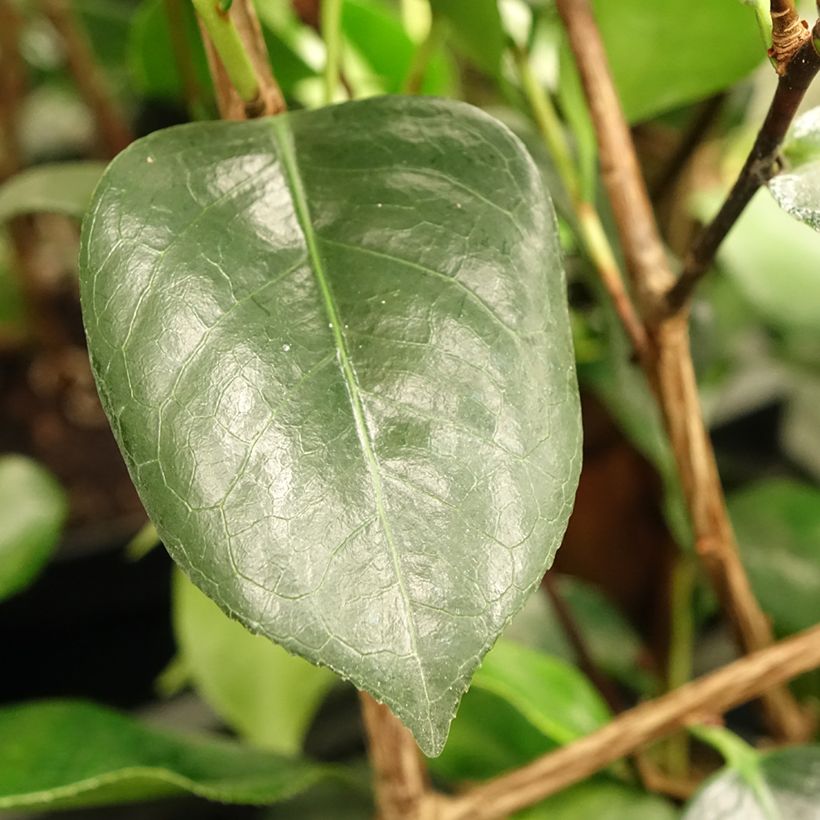

Plant habit
Flowering
Foliage
Botanical data
Camellia
japonica
de Higo Okan
Theaceae
Japanese Camellia, Rose of winter
Cultivar or hybrid
Other Japanese Camellia
Planting and care
Camellia japonica Okan appreciates partial shade or even shade, protected from strong, cold, and dry winds. Plant in a fresh, humus-rich, acidic, and well-drained soil. The bush should not be planted too deeply; cover the top of the root ball with 3 cm (1.2 in) of soil. In winter, cover it with a 5 to 7 cm (2 to 3 in) thick mulch composed of leaf compost and crushed bark. Beware of late frosts that can damage the flowers and buds. Water during dry periods to prevent the bush dropping its flower buds. It is recommended to plant camellias in autumn to promote good rooting and better flowering from the first year. Possible diseases include chlorosis caused by excess limestone, brown spots caused by burns on leaves exposed to full sun, sooty mould, scale insects, and weevils.
Camellias tolerate container cultivation well, their root system forming a dense but shallow network of root hairs. Annual repotting in a slightly larger pot is sufficient. Regularly feed your potted camellia and preferably water it with non-chalky water. If the water in your region is limestone-rich, add a teaspoon of sequestered iron to the watering can every 3 months, from spring to autumn.
Pruning is not necessary but if required should be done sparingly just after flowering, before the emergence of new spring shoots. Most camellia hybrids do not recover from hard pruning.
Planting period
Intended location
Care
This item has not been reviewed yet - be the first to leave a review about it.
Evergreen shrubs
Haven't found what you were looking for?
Hardiness is the lowest winter temperature a plant can endure without suffering serious damage or even dying. However, hardiness is affected by location (a sheltered area, such as a patio), protection (winter cover) and soil type (hardiness is improved by well-drained soil).

Photo Sharing Terms & Conditions
In order to encourage gardeners to interact and share their experiences, Promesse de fleurs offers various media enabling content to be uploaded onto its Site - in particular via the ‘Photo sharing’ module.
The User agrees to refrain from:
- Posting any content that is illegal, prejudicial, insulting, racist, inciteful to hatred, revisionist, contrary to public decency, that infringes on privacy or on the privacy rights of third parties, in particular the publicity rights of persons and goods, intellectual property rights, or the right to privacy.
- Submitting content on behalf of a third party;
- Impersonate the identity of a third party and/or publish any personal information about a third party;
In general, the User undertakes to refrain from any unethical behaviour.
All Content (in particular text, comments, files, images, photos, videos, creative works, etc.), which may be subject to property or intellectual property rights, image or other private rights, shall remain the property of the User, subject to the limited rights granted by the terms of the licence granted by Promesse de fleurs as stated below. Users are at liberty to publish or not to publish such Content on the Site, notably via the ‘Photo Sharing’ facility, and accept that this Content shall be made public and freely accessible, notably on the Internet.
Users further acknowledge, undertake to have ,and guarantee that they hold all necessary rights and permissions to publish such material on the Site, in particular with regard to the legislation in force pertaining to any privacy, property, intellectual property, image, or contractual rights, or rights of any other nature. By publishing such Content on the Site, Users acknowledge accepting full liability as publishers of the Content within the meaning of the law, and grant Promesse de fleurs, free of charge, an inclusive, worldwide licence for the said Content for the entire duration of its publication, including all reproduction, representation, up/downloading, displaying, performing, transmission, and storage rights.
Users also grant permission for their name to be linked to the Content and accept that this link may not always be made available.
By engaging in posting material, Users consent to their Content becoming automatically accessible on the Internet, in particular on other sites and/or blogs and/or web pages of the Promesse de fleurs site, including in particular social pages and the Promesse de fleurs catalogue.
Users may secure the removal of entrusted content free of charge by issuing a simple request via our contact form.
The flowering period indicated on our website applies to countries and regions located in USDA zone 8 (France, the United Kingdom, Ireland, the Netherlands, etc.)
It will vary according to where you live:
- In zones 9 to 10 (Italy, Spain, Greece, etc.), flowering will occur about 2 to 4 weeks earlier.
- In zones 6 to 7 (Germany, Poland, Slovenia, and lower mountainous regions), flowering will be delayed by 2 to 3 weeks.
- In zone 5 (Central Europe, Scandinavia), blooming will be delayed by 3 to 5 weeks.
In temperate climates, pruning of spring-flowering shrubs (forsythia, spireas, etc.) should be done just after flowering.
Pruning of summer-flowering shrubs (Indian Lilac, Perovskia, etc.) can be done in winter or spring.
In cold regions as well as with frost-sensitive plants, avoid pruning too early when severe frosts may still occur.
The planting period indicated on our website applies to countries and regions located in USDA zone 8 (France, United Kingdom, Ireland, Netherlands).
It will vary according to where you live:
- In Mediterranean zones (Marseille, Madrid, Milan, etc.), autumn and winter are the best planting periods.
- In continental zones (Strasbourg, Munich, Vienna, etc.), delay planting by 2 to 3 weeks in spring and bring it forward by 2 to 4 weeks in autumn.
- In mountainous regions (the Alps, Pyrenees, Carpathians, etc.), it is best to plant in late spring (May-June) or late summer (August-September).
The harvesting period indicated on our website applies to countries and regions in USDA zone 8 (France, England, Ireland, the Netherlands).
In colder areas (Scandinavia, Poland, Austria...) fruit and vegetable harvests are likely to be delayed by 3-4 weeks.
In warmer areas (Italy, Spain, Greece, etc.), harvesting will probably take place earlier, depending on weather conditions.
The sowing periods indicated on our website apply to countries and regions within USDA Zone 8 (France, UK, Ireland, Netherlands).
In colder areas (Scandinavia, Poland, Austria...), delay any outdoor sowing by 3-4 weeks, or sow under glass.
In warmer climes (Italy, Spain, Greece, etc.), bring outdoor sowing forward by a few weeks.

































